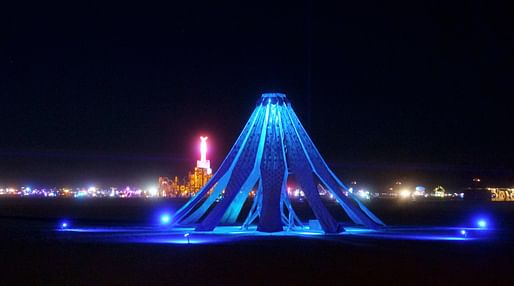
A group of designers, artists, and technologists from MIT have unveiled details of a pavilion delivered by the team for Burning Man 2023. The Living Knitwork Pavilion is described by the group as “an architectural-scale interactive 3D knitted textile shade structure that leverages electrically and optically-active yarns and explores photochromism by day and light-movements interaction at night.”

The modular pavilion comprises a dodecagonal pyramid, measuring 18 feet in height and 26 feet in width. Crafted from 3D knitted yarns that are both optically and electrically active, the pavilion senses movements and changes its color and luminescence in response, creating a unique optic experience across the day and night.
The pavilion is formed of twelve petals, each embedded with functional yarns. The yarns can detect physical interactions through electric-field sensors, subsequently lighting up the structure in real-time. On sunlit days, concealed designs inspired by both humanity's history and visions of the future, encompassing themes from nature to synthetic beings, emerge via photochromism.
During the evening, the Living Knitwork Pavilion transforms into a communal “responsive lantern” where movements and surrounding environmental alterations are reprojected onto the pavilion, creating “living memories, fostering and amplifying moments of discovery, reflection, and connectedness.”

Supporting the knitwork is an asymptotic gridshell: A framework of timber elements designed for structural strength and material efficiency. The grid shell has been shaped with curving geometries to blend with the knitwork, while implemented antennas integrate with the knitwork to receive an electrical field sent by a transmitter pole.

“Ancient textiles and reliefs have played a significant role in shaping the social, economic, and religious structures of communities across the globe,” the MIT team explains. “Iconic Indigenous clothing and carvings are imbued with unique designs and patterns. Some are believed to have magical powers and are designed to carry specific meanings and wishes.”
“As storytelling media, these patterns, symbols, and experiences have brought together a sense of community, identity, and self-expression,” the group adds. “By drawing inspiration from the artistry and construction techniques used in traditional textiles, as well as the notion of a pavilion or pagoda serving as a communal space, we aim to infuse a new perspective of technical textiles by fusing novel materials, sensing technologies, and digital fabrication processes to build an architectural skin and structure in the form of an interactive textile pavilion.”
The MIT Media Lab team behind the pavilion included: Irmandy Wicaksono, Sam Chin (Responsive Environments), Alfonso Parra Rubio, Nicole Bakker, Erik Strand (Center for Bits and Atoms), Gabriela Advincula (City Science), Manaswi Mishra (Opera of the Future), Age van der Mei (MIT CSAIL), Judy Chichoka, and Angelica Zhang (MIT Architecture).
No Comments
Block this user
Are you sure you want to block this user and hide all related comments throughout the site?
Archinect
This is your first comment on Archinect. Your comment will be visible once approved.